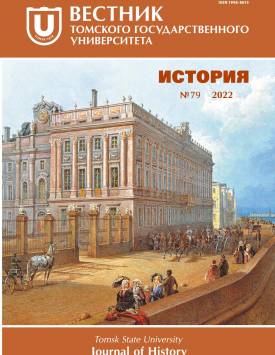Ivan Dolgikh, Head of the Special (Labor) Settlements of Western Siberia: Nomenklatura Rise and Survival of a Personnel Guard (1930-1937)
The biography of Ivan I. Dolgikh (1896-1956) is a common case of ambivalent perception of a person's personality and activity during the change of historical epochs, formed by the era of wars and revolutions, when the type of uncompromising fighter for the victory of the Bolshevik system and then - for its protection from enemies - was glorified. He certainly played a positive role in this historical narrative. With the paradigm shift in the early 1990s, the attention of researchers was focused on the activities of I. I. Dolgikh as an employee of the GULAG, a guardian of the Stalinist regime for a quarter of a century. This publication analyzes the phenomenon of extraordinary nomenclatural survivability of Dolgikh as the head of the system of special (labor) settlements in Western Siberia, together with which he survived during the acute crises of its formation. It is proved that this was facilitated by the very type of personality of Dolgikh, who combined the traits of a tough serviceman acting within the limits of his official functions with the ability to act as decisively as possible in extreme conditions, eliminating or minimizing the dangers to the regional structure subordinate to him. This is a type of "useful guardian", which stood out against the background of huge staff turnover at all levels of the security system of the Stalin era. During his career in the West Siberian region, Dolgikh managed the population of labor settlements with a population of 200 to 300 thousand people with a staff of commandant's offices of 500 - 700 people, whose composition changed annually by at least 10 - 15%. The main value of Dolgikh in the eyes of the higher punitive and regional leadership was his obvious role in achieving and ensuring a certain stability of the special settlement system. In terms of punitive reasoning, Dolgikh fulfilled two main goals set for him during his seven-year term of service: a controlled commandant's complex was created and functioned in the region, providing a regime for the maintenance of exiled peasants and the exploitation of their labor for the implementation of the government's economic plans. At the same time, Dolgikh himself personified one of the essential features of the regime-mobilization type system, the existence of which was ensured by the imperative of survival, not development. In the special settlement segment, there were no positive motives and incentives for productive work, huge resources were absorbed here ("irrevocable costs"), the type of survival was reproduced both for the "special contingent" and for the guards themselves. The authors declare no conflicts of interests.
Keywords
Ivan Dolgikh, type of guard, formation of a network of commandant's offices, personnel potential, repressions, nomenclature survivalAuthors
| Name | Organization | |
| Krasilnikov Sergei A. | Institute of History SB RAS | krass49@gmail.com |
| Teplyakov Alexei G. | Institute of History SB RAS | teplyakov-alexey@rambler.ru |
References

Ivan Dolgikh, Head of the Special (Labor) Settlements of Western Siberia: Nomenklatura Rise and Survival of a Personnel Guard (1930-1937) | Tomsk State University Journal of History. 2022. № 79. DOI: 10.17223/19988613/79/8
